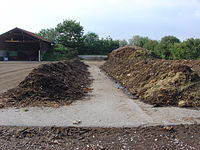
Photo from wikipedia
ABSTRACT Animal manure is the main source of bioenergy production by anaerobic digestion (AD). However, the pathogenic bacteria in manure may pose a high risk to human health by contaminating… Click to show full abstract
ABSTRACT Animal manure is the main source of bioenergy production by anaerobic digestion (AD). However, the pathogenic bacteria in manure may pose a high risk to human health by contaminating the environment if not effectively inactivated during AD. Worldwide, more than 20,000 biogas plants are running for the treatment of animal manure. AD has been playing the important role in establishing a circular economy in the agricultural sector and may contribute to the United Nations sustainable development goal (UN SDG). Nevertheless, whether AD is a reliable approach for pathogens inactivation has been challenged. A comprehensive understanding of the coping mechanisms of pathogens with adverse conditions and the challenges of establishing the AD process to inactivate effectively pathogens are yet to be analyzed. In this review, the diversity and resistance of pathogens in animal manure are summarized. The efficiencies and the difficulties of their inactivations in AD are also analyzed. In particular, three forms of pathogens i.e. sporing-forming pathogens, viable but non-culturable (VBNC) pathogens, and persistent pathogens are discussed. The factors influencing the pathogens’ inactivation and AD efficiencies are analyzed. The trade-off between energy production and pathogens inactivation in an AD system was consequently pointed out. This review concluded that the development of anaerobic processes should meet the goals of high efficient bioenergy production and deep hygienization.
Journal Title: Bioengineered
Year Published: 2022
Link to full text (if available)
Share on Social Media: Sign Up to like & get
recommendations!